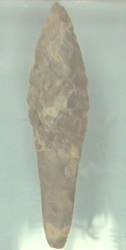
 |
| Fluted points have a channel (a flute) running from the base of the point.This point is from the Wasden site. |
Simple
Lanceolate/Fluted:
Holmer (1986:94)
cites Owl Cave (Wasden) as the only site with fluted points from a secure dated
context radiocarbon dated at c. 13000-11,000 B.P. (Miller and Dort 1978; Miller
1982), and with obsidian hydration dates averaging c. 11,000 B.P. (Green 1983).
Bedwell (1970:180-181) found a slightly fluted lanceolate point on Pleistocene
lake gravels dated c. 13,000 B.P. in the Fort Rock Basin of Oregon (cf. Fagan
1975) and Elmer Smith recovered a similar point in the lowest levels of Danger
Cave (Jennings 1957:47).
Simple
Lanceolate:
Later simple
lanceolate forms in the Great Basin cultural area have been classified under
a variety of labels: Pinto Shoulderless, Humboldt Concave-base and Humboldt
Basal-notched, Triple-T Concave-base, and McKean Lanceolate. Holmer (1986:100)
notes that concave-base lanceolate forms often overlap with bifurcate-stemmed
points in distribution, but have a far longer time span, and implies that the
classification of these forms is far from detailed or complete.
Shouldered
Lanceolate:
Shouldered lanceolate
point variants in the Great Basin may have a roughly comparable age to fluted
lanceolates (Holmer 1986:95). Bedwell (1973:142) recoved a stemmed point from
the same occupation level as the fluted lanceolate point dated c. 13,000 B.P.
Several bases of stemmed points were found at Smith Creek Cave with radiocarbon
dates ranging from c. 12,000--10,000 B.P., and found in direct association with
extinct Pleistocene fauna. Swanson (1972) stemmed lanceolate points at Bison
Rockshelter the Birch Creek Valley of Idaho dated 10,000 B.P. Sargent (1973)
reports recovery Haskett stemmed lanceolate points from Re Overhang in central
Idaho dated c. 10,000-9,000B.P. Bedwell found Haskett type points Connley Caves
in southeastern Oregon dated 11,000-9000 B.P.
Haskett


Shouldered Lanceolate




Later versions of stemmed lanceolate p. include Lake Mohave and Silver Lake variants. These points are usually recovered as surface finds, but Sargent (1973) reports on a Silver Lake point recovered from a stratum at Redfish Overhang dated c. 8000 B.P. Two Lake Mohave or Silver Lake points were recovered at Danger Cave in Stratum DII, dated c. 10,000-9,000 B.P. One Lake Mohave point at Hogup Cave was dated c. 8,000 B.P.
The actual chronological sequence of lanceolate and shouldered lanceolate point forms is not well described for the Great Basin, but the transition from Paleoindian to Early Archaic is marked in distinctive point styles. There is a dimunition is size, morphology, and use of projectile points at this transition exemplified in the development of variants of triangular outline and highly variable haft treatment.